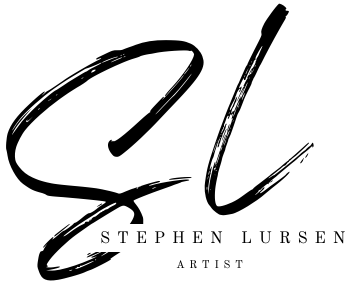Welcome to my blog here at Stephenlursen.com! I'm glad you came! In this post I describe some of the unique qualities of common paintbrush types. I hope this educational video helps you in your search to better understand why there are so many types of brushes at the art supply store and why you would use each type.
The brush types I talk about in this video are:
- 4" house brush - used for painting broad color fields and created large marks on a large surface.
- 2" angled edge brush - used for painting hard wide lines. Excellent for making bold strong lines on a large surface. Can also be used to quickly fill medium sized zones with color.
- Fan brush - commonly used to add texture to a later or top layer of a painting. Used regularly in landscape painting to add foliage.
- Mop brush - soft bristled fluffy brush used in watercolor paintings to soak up large amounts of fluid watercolor paint and then distribute lots of color in one motion. Due to having a very round shape, the lines work created with this brush is much more organic than brushes with hard angles.
- 1" Flat wash brush - This highly used brush is excellent at filling small to medium zones with a wash of color. It can also be turned 90 degrees and used to create dashed lines by painting with the blade instead of the wide angle. Lines created with this brush are typically very sharp due to the hard edge/angle of the brush itself.
- 1" hard bristled bright brush - Short bristled brushes with very firm filaments are used to push paint instead of pulling it. This pushing action creates very different marks and color interactions than those marks made by traditionally pulling a brush across a surface.
- Filbert brushes - Filbert brushes are medium to long bristled brushes that are rounded instead of sharp cornered brushes. The round shape allows the brush to blend a painted surface very easily without creating distinct lines in the painting. Lines created with these brushes are more organic and varied because the more pressure you use, the wider the line, and vis-a-versa.
- Deer foot stippler brush - used to pounce paint upon the surface of a painting to create textured marks.
- Round brushes - used to create lines and details typically in a later stage of a paintings process. The longer the bristles, the more paint it can hold, which correlates to its ability to produce short, medium or long lines before needing to be re-dipped in paint.
- Rigger, liner, script - used to create thin or tiny details and marks that could not be achieved by using a larger brush.
Thank you so much for watching and reading my article! If you have any questions or thoughts I would LOVE to hear them! Please comment below and I will respond.
If you are interested in learning how to use these and other tools to create paintings, please check out my step by step online workshops where you can learn to paint your own original masterpieces! Click the link: https://stephenlursen.com/collections/online-workshops-educational-videos
Happy Painting!
Stephen Lursen Art
If you would like to write to me, please email me at admin@stephenlursen.com

Adam that ? at the end of my comment is a smily face! Apparently I can’t include emojis on my website comments. :(
Thanks Adam!!! I appreciate your kind comment! ?
Excellent! I learned so much!!!